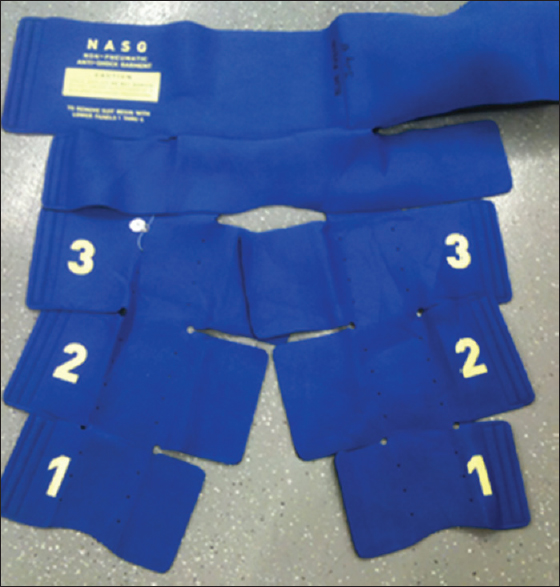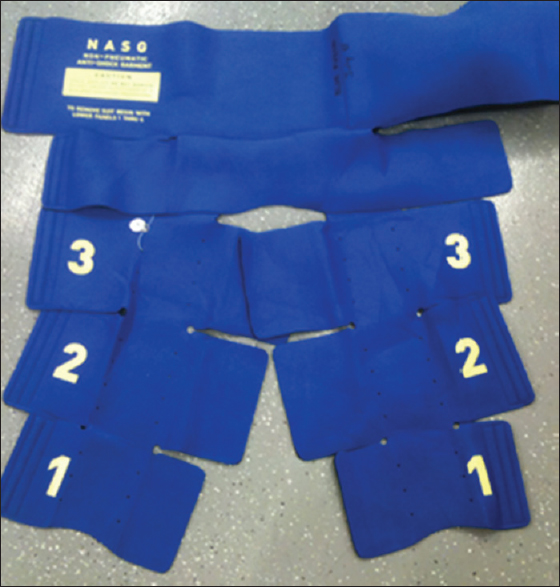NON-PNEUMATIC ANTI-SHOCK GARMENT for PPH care
Valid Article
NON-PNEUMATIC ANTI-SHOCK GARMENT for PPH care
Definition
The Non-pneumatic Anti-Shock Garment (NASG) is a device developed as a temporary measure to gain time, in order to ensure hemodynamic stability and allow patient transfer and/or definitive OH treatment. The NASG is a compression suit made of five neoprene segments that close tightly with Velcro around the legs, pelvis and abdomen. By providing circumferential compression it decreases the vascular volume under the compressed areas, while expanding the central circulation, increasing the preload, peripheral resistance and cardiac output. Furthermore, abdominal, pelvic and uterine vessels' tamponade reduces blood loss.
In short, the NASG helps to control bleeding and reverse shock, ensuring circulation to vital organs.
Specifications
Instructions for use
For detailed instructions on how to apply the NASG, please check the job aids and video available on the training package file.
1. Place NASG under woman;
2. Close segments 1 tightly around the ankles;
3. Close segments 2 tightly around each calf;
4. Close segments 3 tightly around each thigh, leave knees free;
5. Close segment 4 around pelvis;
6. Close segment 5 with pressure ball over the umbilicus;
7. Finish closing the NASG using segment 6.
Segments 1, 2, 3 can be applied by two persons simultaneously, segments 4, 5, 6 should only be applied by one.
If the NASG is applied at a BEmONC facility or at community level, the patient needs to be transferred for further care to a CEmONC facility. A referral form needs to be filled in with all the relevant information – a referral form template can be found in the NASG training package.
If a vaginal intervention is needed to stop the bleeding, the NASG should remain in place. When properly placed, it allows patient's mobility (bending of knees and hip).
If a surgical intervention is needed to stop the bleeding, the segments 4, 5 and 6 can be opened for surgery, but the rest of the NASG should stay in place.
The NASG can only be removed in a CEmONC level under medical supervision after the patient has been stable for at least 2 hours, fulfilling ALL the following criteria: Systolic BP ≥ 90 mmHg / Pulse < 100 bpm / No significant bleeding (< 50 ml/h)
Maintenance
NASG from Delivery and OT: collect in a closed bucket
Cleaning First option: in the Laundry department
- Place the NASG in the washing sink and rinse it under running water while using a brush with long handle to remove any blood or tissue residues
- Manual hand washing: add soap and cool water into the washing basins and wash it using a brush, rinse it thoroughly with water
- OR: Use of domestic washing machine: place the NASG in the domestic washing alone, add washing detergent and choose the cool cycle
- Disinfect the NASG by soaking in 0.1% Chlorine solution for 5 minutes, ensure the device is covered by the solution ( If you feel the devise is floating in the solution you might need to use a heavy object to keep it soaked)
- Rinse it 3 times under running water / Rinse 3 times in the washing machine
- Squeeze it as much as you can to remove excess water / Spin to remove excess water
Cleaning Second option: in the Sterilization department
- Place the NASG in a bucket filled with approved MSF detergent disinfectant diluted solution e.g. Anios Excel D, hexanios,to pre-disinfect for 15 minutes ( If you feel the devise is floating in the solution you might need to use a heavy object to keep it soaked). Do not handle the NASG during this time.
- Remove the NASG from the pre-disinfection solution, place it in the sink under running water while using a brush
- Soak it again in the second disinfection bucket with approved MSF detergent /disinfectant ( Anios Excel D , Hexanios) for 15 minutes contact times( If you feel the devise is floating in the solution you might need to use a heavy object to keep it soaked)
- After 15 minutes of contact, rinse the device well under running water
- Squeeze it as much as you can to remove excess water
Untangle the NASG. The Velcro will have stuck to itself and stuck to other parts of the NASG. Separate all the Velcro and all the segments so that they can dry, Hang the NASG to dry, preferably indoors
Folding and storing the NASG correctly is key to being able to unfold it and apply it quickly to the next patient in shock. When the NASG is not folded correctly, unfolding it is difficult and wastes time in an emergency.
- Spread the NASG on a clean, flat, dry surface
- Begin with segment pair #1. Fold the Velcro side onto the inside of the segment, not closed on the outside.
- Then fold the non-Velcro side on top of the Velcro side. If done correctly, the Velcro will not be tightly fastened, nor visible
- Fold segment pairs #2 and #3 in the same way.
- Fold the leg segments upward like a map or fan onto segment pair #3.
- Fold the leg segments up onto the abdominal segment, #6.
- Fold segment #4 in the same way: close the side of the segment with the Velcro to the inside. Cover with the non-Velcro side. Fold segment #4 up over the folded leg segments.
- Fold segment #5 (with the pressure ball) across the leg and pelvic segments. Wrap segment #6 tightly around segment #5
The NASG is now ready to be applied quickly to the next patient
Storage
Store the NASG in a clean dry place. Keep it in a clear plastic bag. It should be kept accessible for an emergency.
MSF requirements
UNICEF and the NASG manufactures recommend the use of 0,01% of Chlorine for disinfection of the NASG and the device can be used 40 times.
MSF cleaning and disinfection protocol recommends a concentration of 0.1% Chlorine (instead of 0,01%) for disinfecting the device (based on WHO recommendations).
MSF will need to evaluate if the life span of the device will be affected by the stronger concentration of Chlorine.




